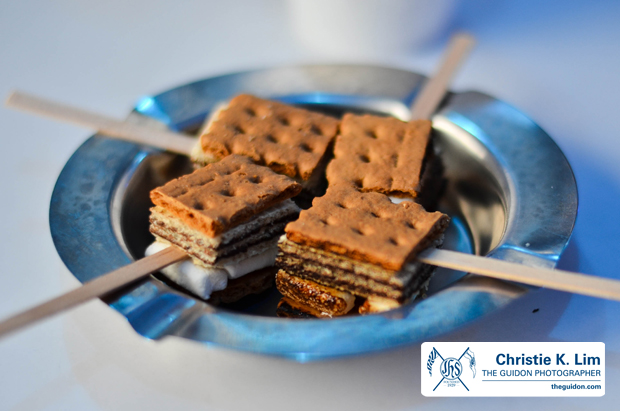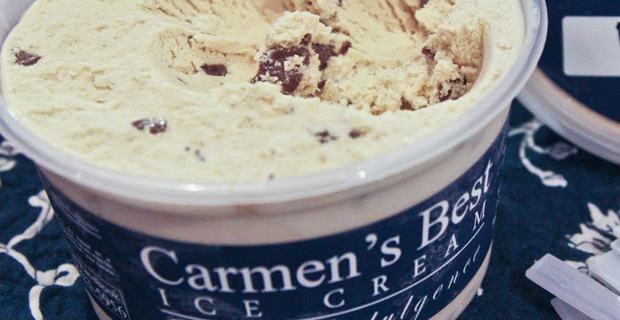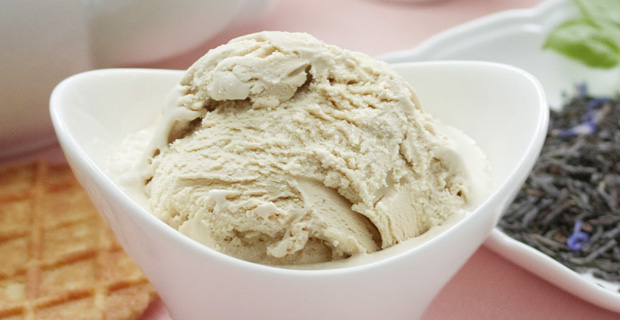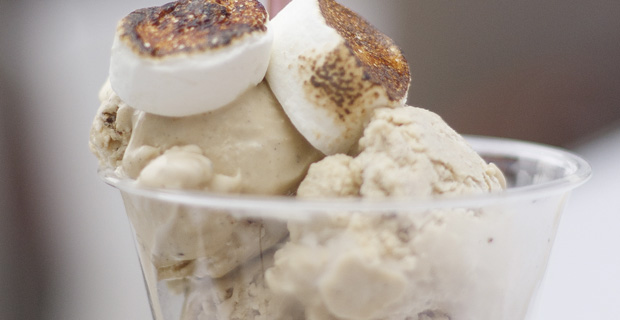
MAKE IT COOL. The iScreamist’s Dragon’s Breath S’mores take a different approach to traditional ice cream. Photo by Christie K. Lim.
Ice cream is a year-round sport. It’s the staple of date nights, family reunions and gossip sessions. It’s the quick fix for broken hearts and awkward silences, the premise of a love story and the backdrop for heartache. Ice cream is the alternative to grabbing coffee, the solution to hangovers, the end of a grueling workday.
In the sun-scorched Philippines, ice cream is especially dear. Besides providing respite on a humid day, it’s also about the unmistakable song that marks the approach of a Selecta cart. It’s about cracking Twin Popsies and sharing it with a friend, about watching the sorbetero scooping dirty ice cream high onto a little wafer cone.
And as with the occasions for consuming it, the choices for ice cream are just that: boundless.
Retro fit
For many, the first taste of ice cream comes from a commercial ice cream brand, such as Nestle or Arce Dairy.
In fact, members of Generation Y have probably heard stories from their parents about the Magnolia Ice Cream House in New Manila as the go-to place back in the ‘80s. Resurrected in the newly opened Robinsons Magnolia mall, younger generations can enjoy ice cream as their parents did. Otherwise, it’s a staple at any local grocery and boasted of in countless ads.
This accessibility clearly demonstrates the edge commercial ice cream has over its more modest cold cousins. “The big players will always have that advantage over small scale producers in terms of a war chest to invest in advertising, shops, distribution,” says Ian Carandang, who owns artisan ice cream brand Sebastian’s.
However, while the reach and accessibility of commercial ice cream is unparalleled, the same can’t be said in terms of mouthfeel. “The overrun of commercial ice cream is very, very high,” says Carandang, referring to the volume of air churned into the mix. The general rule is that the higher the overrun, the more bland and airy the ice cream turns out. “You can really feel the difference in your mouth in the butterfat level.”
There’s also the issue of unexciting flavors. Feeling the heat from artisan ice cream makers and their specialized flavors, commercial ice cream has recently been trying out its adventurous side. Selecta’s chef-endorsed Gold line and Nestle’s team-ups with chocolate brands Kitkat, Baby Ruth and Maltesers, for example, put some excitement into their usual fare. However, by virtue of its mass production, commercial ice cream simply doesn’t enjoy the flexibility of flavor experimentation.
For this reason, big name manufacturers tend to play it safe, as seen in their universal and fuss-free flavors: Vanilla, Chocolate, Cookies ‘n Cream. Rather than turning them away, though, these brands allow their loyal customers to precisely find comfort in their products’ consistency and widespread availability.
“There’s something about the familiar, the tried and tested that makes you keep going back to [commercial ice cream], even if you have other options,” says communication major Apple Nocom. With commercial ice cream, you know exactly what you’re going to get.
New cool
Nevertheless, artisan ice cream has gained traction, with more and more brands popping up all over the Metro and putting their offerings on the table.
Artisan ice cream distinguishes itself from other types of ice cream with its use of premium ingredients, with some brands even dedicating themselves to solely using materials that are organic or free-range.
This preference for such high-quality ingredients is also how artisan ice cream offers much more complex or uncommon flavors. “They’re open to taking the risk of playing with expensive ingredients that need to be sourced from all over. They use real French Vanilla, liqueur, chocolate, cheese, spices and whatever,” explains Yummy magazine editor Zee Castro-Talampas. “They’re just more experimental with their process.”
In fact, it was frustration with “safe” flavors that inspired Carandang to start Sebastian’s, which has earned him the reputation as one of the leading purveyors of artisan ice cream. He deadpans, “[Before the Philippines had artisan ice cream,] the height of imagination was to put chocolate crinkles in vanilla ice cream and call that a new flavor.”
With increasing presence in shopping malls and food markets, artisan ice cream’s reach is growing. Still, it’s a miniscule enterprise when compared to giants like Häagen-Dazsand, surprisingly enough, that’s exactly how Carandang likes it.
“We aren’t as beholden as the large scale manufacturers to the bottom line. We are more flexible and can develop and release new flavors far quicker than they can,” he points out. “We can work with higher quality ingredients and take more risks in flavor design.”
While there are financial disadvantages to competing with larger ice cream brands, which have seemingly unlimited resources, Carandang believes in the processes that give artisan ice cream its edge. With other food fads such as frozen yogurt or milk tea, Carandang explains that “all anyone needed was seed money to invest in the machines and some batch mixes and let the money roll in.”
Artisan ice cream, on the other hand, requires a definite creative hand. It has to have a person with a point of view and selling point.
True grit
For all the creativity of artisan ice cream and the ubiquity of commercial brands, both have yet to depose the true ice cream of the Philippines: sorbetes.
Traditionally made with coconut milk, sorbetes is the country’s very own take on the cold dessert. As Carandang puts it, sorbetes is to the Philippines what gelato is to Italy.
Apart from its ingredients, sorbetes is unique in its serving style as well. More commonly known as dirty ice cream, it s peddled in wheeled carts by street vendors called sorbeteros. Customarily, sorbeteros walk around with three complementary flavors that work well alone, in twos, or all together. A scooper small in circumference makes it possible to stack the ice cream quite high into a choice of either a wafer cone orfor a truly local take on the ice cream sandwicha piece of pandesal. The sorbetero’s swift, deft, almost mechanical scooping movements are a sight to behold.
Its being sold on the street is the root of its dubious quality, but it is also the envy of artisan ice cream makers.
“Sorbetesthe way it is currently marketedis still the ice cream of the masses, in that you can find it in any neighborhood, and the price is very low,” says Carandang. “The reach and accessibility of it is way more than anything I could ever dream of.”
It may have the upper hand when it comes to reach, but the same cannot be said of sorbete’s quality. With its light and sometimes gritty texture, sorbetes isn’t quite as creamy as the other species in its frozen family. Nor is it as diverse, as a sorbetero’s cart can carry only three flavors at a time.
Though these flavors do change every now and then, they are never particularly adventurous. They may take a chance on avocado or strawberry, but for the most part, sorbeteros keep to long-standing favorites like cheese, chocolate, and ube.
Such starkly dissimilar flavors all in one serving ought to be strange, but the tastes aren’t profoundly different. Carandang describes sorbetes as “lacking in richness, as they work with cheaper ingredients and the mindset is more about mass production than artisanal quality.” This would be a weak point if we were talking of artisan or commercial ice cream, but this is precisely what keeps the otherwise peculiar combination of flavors palatable.
Perhaps it isn’t quality, then, but cultural comfort that makes the appeal of sorbetes unshakable. “I love dirty ice cream. No buts. It’s the stuff of my childhood, so I really do look for it a lot of the time,” shares Nica Bengzon, an English literature senior and ice cream enthusiast.
Comparative politics
Trends may come and go, but ice cream is a universal love that resonates beyond time and space. It has transcended the functionality of refreshment and taste, transformed into an experience that is truly personal.
Castro-Talampas sums it up perfectly: “Someone might go for commercial ice cream because it reminds him of the best birthday party he had when he was six,” she says. Or someone might like sorbetes because when she was little, her dad would always treat her to a scoop after her swimming lessons during summer. Or a pint of artisan ice cream might remind a person of an orange liqueur she enjoyed while traveling in Europe.
“You can’t say that one is better than the other even if some ice creams are more expensive and use better ingredients. It’s the memories you have and the feeling you get that makes ice cream special.”
The Scoop
The GUIDON lists the best in artisan ice cream.
Written by Andrea S. Ang and Arianna Y. Lim
Carmen’s Best
When it comes to quality, Carmen’s Best is the brand to beat. Be it pure Tahitian vanilla or fresh milk from his family’s farm, owner Paco Magsaysay settles for nothing less than the finest ingredients.
Indulge in: Salted Caramel, Malted Milk, Coffee, Butter Pecan
Pinkerton
Xandra Rocha’s taste profiles are in a class of their own. Never too much or too little, these gorgeously packaged pints are always spot-on.
Indulge in: Guava Basil Sorbet, Red Velvet, Candied Maple Bacon
Merry Moo
Innovation is the name of the game in the world of artisan ice cream. Merry Moo has this in the bag with creative flavors like Earl Grey Tea, Strawberry Basil, and Poprocks and Mallows.
Indulge in: Sea Salt Caramel, Earl Grey Tea
Homemade by Roshan
Roshan’s pastries and specialty desserts are a must-try, but for a one-two punch, grab a pint of ice cream: they mix their other goodies in to produce flavors that are truly uniquely theirs.
Indulge in: Ghirardelli chocolate chip cookie with Nutella swirl, Food for the Gods
iScreamist
Made on the spot with liquid nitrogen, the iScreamist injects its own science-experiment fun in redefining the ice cream experience.
Indulge in: Toasted Marshmallow, Blueberry Cheesecake











